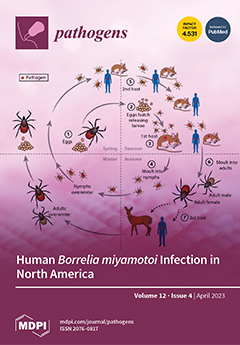An exceptional gut-colonizing ability may underlie the dramatic epidemiological success of the multidrug-resistant
H30R subclone of
Escherichia coli sequence type 131 (O25b:K+:H4). In order to inform the development of colonization-preventing measures, we studied systemic immune correlates of
H30R intestinal colonization. Human
[...] Read more.
An exceptional gut-colonizing ability may underlie the dramatic epidemiological success of the multidrug-resistant
H30R subclone of
Escherichia coli sequence type 131 (O25b:K+:H4). In order to inform the development of colonization-preventing measures, we studied systemic immune correlates of
H30R intestinal colonization. Human volunteers’ fecal samples were screened for
H30R by selective culture and PCR. Subjects were assessed by enzyme immunoassay for serum levels of anti-O25 IgG (representing
H30R) and anti-O6 IgG (representing non-
H30
E. coli generally), initially and for up to 14 months. Whole blood was tested for the antigen-stimulated release of IFNγ, TNFα, IL-4, IL-10, and IL-17 after incubation with
E. coli strains JJ1886 (
H30R; O25b:K+:H4) or CFT073 (non-
H30; O6:K2:H1). Three main findings were obtained. First,
H30R-colonized subjects had significantly higher anti-O25 IgG levels than controls, but similar anti-O6 IgG levels, suggesting an IgG response to
H30R colonization. Second, anti-O25 and anti-O6 IgG levels were stable over time. Third,
H30R-colonized subjects exhibited a lower TNFα and IL-10 release than controls in response to strain JJ1886 (
H30R) relative to strain CFT073 (non-
H30R), consistent with TNFα hypo-responsiveness to
H30R possibly predisposing to
H30R colonization. Thus,
H30R-colonized hosts exhibit a sustained serum anti-O25 IgG response and an underlying deficit in TNFα responsiveness to
H30R that could potentially be addressed for colonization prevention.
Full article






